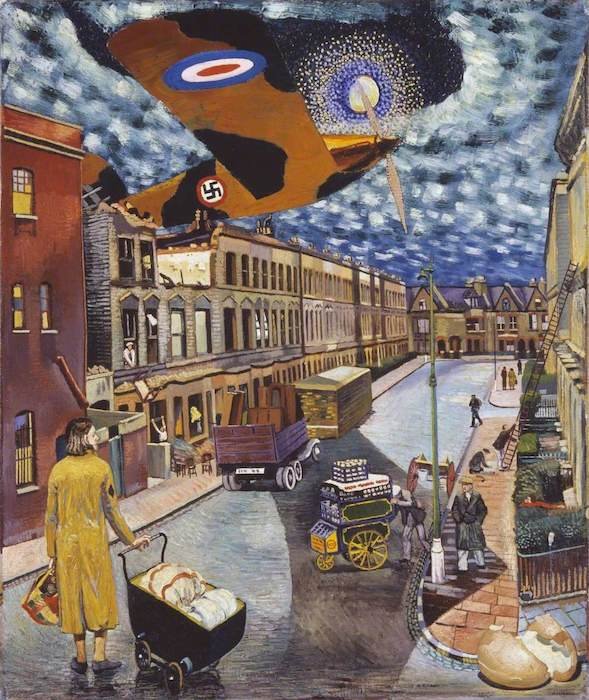
Walter Nessler called this painting Premonition. A premonition of what? It’s clearly London, judging from St Paul’s, the double deckers, and so on, but it’s an unsettling version. Everything is jumbled together and smothered by blood-red clouds. But apart perhaps from the ominous sky, the only direct evidence of what’s wrong with this picture is the surreal image of the giant gas mask on top of the building being constructed (or deconstructed). Nessler was a refugee from Nazi Germany, and painted Premonition in 1937, the same year that his former countrymen bombed Guernica, a known inspiration for artistic protests against aerial bombardment. Clearly we may take this as his certainty — a premonition suggests a supernatural inevitability — that his new home was going to suffer a similar fate to the cities of Spain. (Although back in 2005 there was some journalistic silliness over the fact that two of the buses display the numbers 77 — 7/7 — and 30 — the route of the bus blown up in Tavistock Square.)

Thanks to Ricardo Reis for this, which has a similar title: Premonitions of the Blitz. It’s dated 1940, and the use of the word ‘Blitz’ proves that its creator, Julian Trevelyan, at least named the painting after the start of major bombing. But again there’s that word ‘premonition’, which suggests that it may have been painted before then. Otherwise it’s harder to interpret than Premonition. There are factories in the background, workers in the foreground (one with a flat cap?). The sky is ominous once again, but now there are weird lines going from one of the clouds to one of each of the workers’ eyes, which is especially unsettling since those eyes look like windows of some kind. And one eye looks like guns maybe? The whole thing is a bit disturbing, but the threat is vague and non-specific.

The next two paintings clearly date to the Blitz or later. This, by Arthur R. Harrison, is entitled The Long Night: London Blitz, and seems to show a family in a shelter, perhaps a private or street one, rather than a Tube station, judging from the homely touch of the table and lamp. The mother and her son have eerily shadowed eyes. They all look tired, despondent, perhaps even defeated. It’s not quite Keep Calm and Carry On.

By contrast, Clive Branson’s Bombed Women and Searchlights at first seems more cheerful. It’s relatively bright and colourful, and the woman at the centre-left seems to embody the injunction of the banner on the left, ‘SMILE AND SAY VICTORY!’ But this is undermined by the details: there is evidence of bomb damage all around (the broken chair in the street, the blocked-off streets, what looks like a crater in the background and perhaps an ambulance being loaded), defeatist grafitti (‘VOTE JOYCE FOR PEACE’), children playing listlessly in the dark. Anyway, Branson was a Communist who had fought in Spain (the smiling woman is possibly his wife, Noreen, official historian of the Communist Party of Great Britain), so we might infer that he was not sn uncritical supporter of the British war effort, as I think another of his paintings from this time, Blitz: Plane Flying, makes clear:

I began this post by looking at a couple of paintings which anticipated the aerial bombardment of British cities in the next war (or the current one), and ended with some painted during the Blitz or else not long after. While it’s a tiny and unrepresentative sample (where’s John Armstrong, for one?), the contrast interests me. The premonitionary paintings are nightmarish without quite making clear the source of their terror; the Blitz ones are anything but vague, and could almost be based on photographs. But in their way they are just as disturbing in the way they don’t conform to the public narrative of defiance and insouciance, even as they mimic the form of the propaganda used to convey it. It’s precisely because that critique didn’t find its way into the memory of the Blitz that these paintings seem so jarring now.
Image sources: Art UK (Branson; Branson; Harrison; Trevelyan); White Noise (Nessler — read the article by Darran Anderson too!)
![]() This work is licensed under a Creative Commons Attribution-NonCommercial-NoDerivatives 4.0 International License.
Permissions beyond the scope of this license may be available at http://airminded.org/copyright/.
This work is licensed under a Creative Commons Attribution-NonCommercial-NoDerivatives 4.0 International License.
Permissions beyond the scope of this license may be available at http://airminded.org/copyright/.


